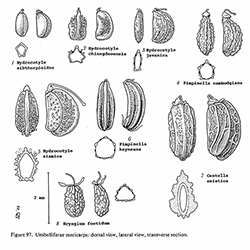e-Flora of Thailand
Volume 5 > Part 4 > Year 1992 > Page 447 > Umbelliferae > Centella
Centella asiatica (L.) Urbanwfo-0000594096
in Mart. & Eichler, Fl. Brasil. 11.1: 287, t. 78, fig. 1. 1879; Domin, Bot. Jahrb. 41.1: 158. 1908; Chermezon in Fl. Gen. I.-C. 1134, fig. 135, 1–3. 1923; Nannfeldt (Revision des Verwandtschaftskreises von Centella asiatica), Svensk Bot. Tidskr. 18: 397. 1924; Craib in Fl. Siam. En. 1: 786. 1931; Merr., Comm. Lour. 293. 1935; Buwalda in Fl. Males., Ser. 1, Spermat. 4: 117, fig. 1c. 1949; Hiroe, Umbell. Asia 1: 11. 1958; Hiroe, Dansk Bot. Ark. 20: 193. 1962; Back. & Bakh.f., Fl. Java 2: 173. 1965; Tard.–Blot in Fl. C.L.V. 5: 24, fig. 2, 1–5. 1967; Hiroe, Acta Phytotax. Geobot. 22: 142. 1967; Wang Tieh-seng in Fl. Reip. Pop. Sini. 55.1: 31, fig. 10, 1979; Emboden (Centella asiatica: elixir of life?), Pacif. Hort. 41.3: 16. 1980. Fig. 97: 7.
Accepted Name : This is currently accepted.
Description : Creeping herb with ± glabrous stems to several dm in length; leaf rosettes often distant. Leaves 0.5–4.5 by 0.8–5.5 cm, 1–4(–16) per rosette, glabrous or villous below, margins crenate; petiole 0.5–25 cm, scariously winged at base, glabrous to densely villous. Bracts ca 2 mm long, ovate-elliptic, scarious, soon deciduous. Rays (1–)3–5(–9), 2–15 mm, glabrous or villous. Bracteoles ca 2, ca 1.5 mm long, broadly ovate-elliptic, scarious. Pedicels ca 3, 0–1 mm. Petals 1–1.5 mm. Fruit ca 2 by 3 mm; styles 0.5 mm.
Thailand : NORTHERN: Chiang Mai (Doi Suthep, Doi Inthanon), Chiang Rai (Doi Tung), Tak (Wang Chao), Phitsanulok (Thung Salaeng Luang); NORTH-EASTERN: Loei (Phu Ruea), Nong Khai; CENTRAL: Krung Thep Maha Nakhon (Bangkok), Nakhon Nayok (Nang Rong); SOUTH-EASTERN: Chon Buri (Sattahip), Trat (K0 Chang, Khlong Son); SOUTH-WESTERN: Prachuap Khiri Khan (Bang Saphan).
Distribution : Tropical and subtropical regions of the world (India – type).
Ecology : Pond and streamsides, evergreen forests, fields, or as a garden weed, 300–1,450 m alt.
Vernacular : Bua bok (บัวบก)(Central); phak nok (ผักหนอก)(Northern, Northeastern).
Uses: Used raw or cooked and eaten with rice; as a tonic or a medicament for skin diseases, including leprosy (see Nature 163: 258. 1949). BUWALDA (1949) reports a capacity for holding soil against erosion.
Notes: Although some varieties, based on indumentum and leaf characters, have been recognized in this pantropical species (cf. Buwalda in Blumea 2: 134. 1936), the range of variation is slight and does not merit formal recognition.

